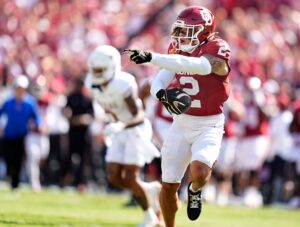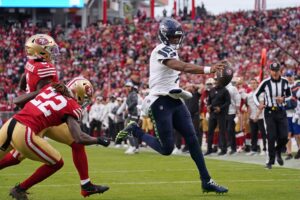When discussing NFL quarterbacks, there are usually two categories assigned to the league’s 32 starting signal callers: the game’s elite, and everyone else. While there is no consensus as to what “elite” truly means, everyone seems to have his or her own definition of what it means to be a top player at the position. In today’s NFL, very few quarterbacks are viewed as being a part of this group. Beyond this elite tier, there is a large group of passers who jockey for position as consensus top-ten options at the position.
Now in his eighth NFL season, Detroit Lions quarterback Matthew Stafford has seldom been assigned this distinction. His critics have pointed to low win totals and a propensity for turnovers to discredit his candidacy for top-ten quarterback status.
To be fair, these criticisms haven’t been entirely wrong. Stafford’s career hasn’t always gone the way that Lions fans had hoped when the team made him the first overall selection of the 2009 NFL Draft. Stafford would likely admit to this himself. However, recent history indicates that the University of Georgia product is on a path toward newfound relevance as his career opens a brand new chapter.
Matthew Stafford is Poised to Become a Top Tier NFL Quarterback
Really, this could have been the headline for many a column after Stafford’s brilliant 2011 campaign. At the age of 23, he played in 16 games for the first time in his young career and the results were sensational. The youngster threw for 5,038 yards (eighth-highest in league history), 41 touchdowns (tied for ninth-highest in league history), and 16 interceptions, good for a completion percentage of 63.5, and a 97.2 passer rating. These statistics were made even more relevant because the Lions cruised to a 10-6 record and made a playoff appearance for the first time in twelve years. All the pundits were ready to proclaim Stafford one of the game’s brightest young stars.
Unfortunately, things seemed to stall out after that fantastic season. The next three years of Stafford’s career saw both the team’s win totals and his own personal statistics regress. All of a sudden, public perception of Stafford went from “brilliant young quarterback” to “middle-of-the-pack starter”, at least in the eyes of fans and the media.
Critics would point to the fact that if it weren’t for the brilliance of Calvin Johnson, one of the game’s most dominant receivers of all-time, Stafford’s overall performance would be seen as mediocre at best. Even in 2014, a season in which the Lions won eleven games and returned to the post-season, Stafford’s play was often criticized. It seemed that no matter what he did, he was bound to be disrespected.
A Turning Point
In 2015, things reached a new low. The Lions stumbled out of the gate to a 1-7 start, and suddenly Stafford’s future in Detroit seemed cloudy. He had been benched in a Week Five 42-17 thrashing doled out by the Arizona Cardinals, his offensive coordinator Joe Lombardi had been relieved of his duties in favor of quarterbacks coach Jim Bob Cooter after a Week Seven 28-19 loss to the Minnesota Vikings, and the men who drafted him, general manager Martin Mayhew and team president Tom Lewand, were let go after a 45-10 Week Eight drubbing at the hands of the Kansas City Chiefs in London. The season was essentially over, the franchise was looking yet another rebuild square in the eye, and a new regime was on the horizon. What was next for Stafford?
Arguably, the best eight-game stretch of his career.
Stafford’s play in the second half of 2015 is one of the least publicized stories of the year. After all, how much attention does a 1-7 team really get in the NFL media? Nevertheless, the numbers don’t lie. With Cooter as his offensive coordinator, Stafford’s play reached a level that exceeded even his 2011 brilliance. Over the final eight games in 2015, Stafford threw for 2,179 yards, 19 touchdowns, and only two interceptions, to go along with a sparkling completion percentage of 70.0, and a sterling 110.1 passer rating. The team went 6-2 over the second half of the season and all of a sudden things were looking up.
A Legend Retires
Then, of course, the unthinkable happened. Calvin Johnson retired after nine dominant seasons. As much promise as Stafford had shown over the second half of 2015, how could he possibly succeed without one of the all-time greats in the lineup?
The answer to this question is complicated. Players like Johnson are irreplaceable. The void left in a lineup when a superstar player retires is massive. The Lions, however, adapted as best they could. Cooter has proven to be an astute offensive coordinator, which is remarkable considering his youth (32 years of age) and how little experience he had prior to this job. Much of Stafford’s dominant 2015 second half can be attributed to Cooter’s understanding of his quarterback’s strengths. It isn’t so much that Cooter “simplified the game plan” as much as that he adapted it to minimize risk and maximize efficiency. The team’s reliance on the deep ball was all-but eliminated, and the high-percentage game was emphasized.
These trends and principles have been amplified in preparation for 2016. Without Johnson in the lineup, the passing offense no longer has a field-stretching, triple-team requiring, big-play waiting to happen in the lineup. Cooter understands this and has made the necessary adjustments to compensate for the lack of such a threat.
A Large Supporting Cast
Additionally, Stafford is not lacking for weapons. While he is forced to do without the franchise’s all-time leading receiver, he figures to enjoy one of the deepest and most diversely talented groups of pass-catchers of his career. None of Golden Tate, Marvin Jones, Anquan Boldin, Eric Ebron, Theo Riddick, or Ameer Abdullah is Calvin Johnson, but they are all capable contributors in the passing game.
In the opening contest of 2016, each of these men played a role in the Lions’ thrilling 39-35 last-minute victory over the Indianapolis Colts. None of them, however, played a bigger role than Stafford. Continuing his torrid stretch of play, Stafford completed 79.5 percent of his passes for 340 yards, three touchdowns, and no interceptions, to go along with a 128.6 passer rating. He displayed touch and accuracy, and even more importantly than that, he displayed fire.
During the game-winning field goal drive, Stafford showed a level of passion that a lot of football people hadn’t necessarily seen in such an explicit manner. He let his teammates know when they made crucial mistakes, and he let them know forcefully. It’s unlikely the laid-back Stafford will make a habit out of yelling at his teammates (nor should he), but in this instance, he showed a level of competitiveness that a lot of football people found refreshing.
The Next Step
It’s far too early in the 2016 season to make brash proclamations, but one thing is clear; Matthew Stafford is playing some of the most efficient football of his career, and the Lions are better for it. Much of this has to do with the game plan, but a great deal of it has to do with Stafford maturing as an NFL quarterback.
What makes a truly elite quarterback? There are a lot of factors, and while nothing Stafford does in a single season can vault him into that exclusive category, he does appear ready to take the next step in his development. This may be the season where Stafford cements himself as a top-ten quarterback in the National Football League, and for most franchises, that is the first step to a winning formula.
Main Photo:






